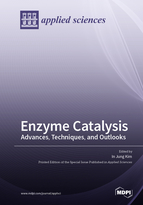Enzyme Catalysis: Advances, Techniques, and Outlooks
A special issue of Applied Sciences (ISSN 2076-3417). This special issue belongs to the section "Applied Biosciences and Bioengineering".
Deadline for manuscript submissions: closed (15 April 2022) | Viewed by 31474
Special Issue Editor
Interests: biocatalysis; enzyme kinetics; protein engineering; biochemical assay
Special Issues, Collections and Topics in MDPI journals
Special Issue Information
Dear Colleagues,
Enzyme catalysis can be applied in a variety of industrial fields, such as biorefinery, biochemicals, foods, pharmaceuticals, etc. As a greener and more selective process, enzyme catalysis is a powerful tool as an alternative to chemical catalysis for the sustainable production of desired compounds. The basic requirements for enzymes to be used as catalysts in industrial applications are high catalytic efficiency, high thermostability, and desired substrate scope. As represented by Frances Arnold’s win of the Nobel prize in 2018, protein engineering technology is making scaled-up industrial applications of enzymes even more real.
This Special Issue covers comprehensive topics and technologies on industrial enzymes and aims to contribute to the development of relevant fields. We warmly invite your submissions to this Special Issue on “Enzyme Catalysis: Advances, Techniques, and Outlooks” to explore recent advances and technologies in the field of enzyme catalysis.
Dr. In Jung Kim
Guest Editor
Manuscript Submission Information
Manuscripts should be submitted online at www.mdpi.com by registering and logging in to this website. Once you are registered, click here to go to the submission form. Manuscripts can be submitted until the deadline. All submissions that pass pre-check are peer-reviewed. Accepted papers will be published continuously in the journal (as soon as accepted) and will be listed together on the special issue website. Research articles, review articles as well as short communications are invited. For planned papers, a title and short abstract (about 100 words) can be sent to the Editorial Office for announcement on this website.
Submitted manuscripts should not have been published previously, nor be under consideration for publication elsewhere (except conference proceedings papers). All manuscripts are thoroughly refereed through a single-blind peer-review process. A guide for authors and other relevant information for submission of manuscripts is available on the Instructions for Authors page. Applied Sciences is an international peer-reviewed open access semimonthly journal published by MDPI.
Please visit the Instructions for Authors page before submitting a manuscript. The Article Processing Charge (APC) for publication in this open access journal is 2400 CHF (Swiss Francs). Submitted papers should be well formatted and use good English. Authors may use MDPI's English editing service prior to publication or during author revisions.
Keywords
- Enzyme catalysis
- Biocatalysis
- Protein engineering
- Enzyme kinetics
- Biochemical analysis
- Industrial enzyme






